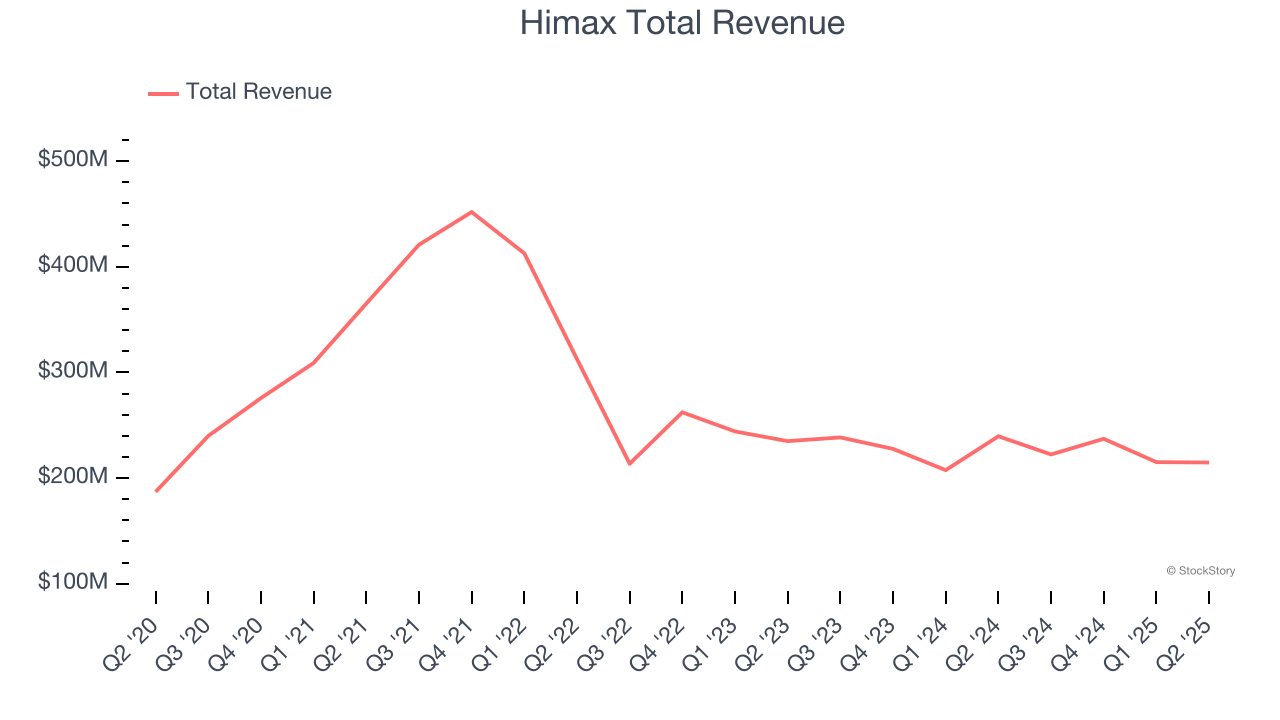
The end of the earnings season is always a good time to take a step back and see who shined (and who not so much). Let’s take a look at how analog semiconductors stocks fared in Q2, starting with Himax (NASDAQ: HIMX).
Demand for analog chips is generally linked to the overall level of economic growth, as analog chips serve as the building blocks of most electronic goods and equipment. Unlike digital chip designers, analog chip makers tend to produce the majority of their own chips, as analog chip production does not require expensive leading edge nodes. Less dependent on major secular growth drivers, analog product cycles are much longer, often 5-7 years.
The 15 analog semiconductors stocks we track reported a satisfactory Q2. As a group, revenues beat analysts’ consensus estimates by 2% while next quarter’s revenue guidance was in line.
In light of this news, share prices of the companies have held steady as they are up 1.3% on average since the latest earnings results.
Weakest Q2: Himax (NASDAQ: HIMX)
Taiwan-based Himax Technologies (NASDAQ: HIMX) is a leading manufacturer of display driver chips and timing controllers used in TVs, laptops, and mobile phones.
Himax reported revenues of $214.8 million, down 10.4% year on year. This print exceeded analysts’ expectations by 1.3%. Despite the top-line beat, it was still a softer quarter for the company with EPS in line with analysts’ estimates and an increase in its inventory levels.
“Starting in August, the U.S. began clarifying its tariff measures toward most of the countries, including major economies such as Japan and the EU. These developments have helped reduce uncertainty in the global trade environment. That said, less than 24 hours ago, the U.S. government announced plans to impose tariffs of approximately 100% on semiconductor chips imported from companies that do not manufacture in the United States. As the details of the new tariff plan have yet to be released, we are unable to comment further regarding its potential impact at this time. We are closely monitoring the situation and will respond accordingly. It's worth noting that tariffs have not had a significant direct impact on Himax’s business, as our IC products are not directly exported to the U.S. Instead, they are integrated into panels or modules by customers outside the United States and then sold globally, including into the U.S. market. Only a negligible portion, about 2%, of Himax’s products are shipped directly to the United States,” said Mr. Jordan Wu, President and Chief Executive Officer of Himax.

Unsurprisingly, the stock is down 5.4% since reporting and currently trades at $8.17.
Read our full report on Himax here, it’s free.
Best Q2: Impinj (NASDAQ: PI)
Founded by Caltech professor Carver Mead and one of his students Chris Diorio, Impinj (NASDAQ: PI) is a maker of radio-frequency identification (RFID) hardware and software.
Impinj reported revenues of $97.89 million, down 4.5% year on year, outperforming analysts’ expectations by 4.3%. The business had an exceptional quarter with a significant improvement in its inventory levels and a beat of analysts’ EPS estimates.

The market seems happy with the results as the stock is up 53.1% since reporting. It currently trades at $187.51.
Is now the time to buy Impinj? Access our full analysis of the earnings results here, it’s free.
Vishay Intertechnology (NYSE: VSH)
Named after the founder's ancestral village in present-day Lithuania, Vishay Intertechnology (NYSE: VSH) manufactures simple chips and electronic components that are building blocks of virtually all types of electronic devices.
Vishay Intertechnology reported revenues of $762.3 million, up 2.8% year on year, in line with analysts’ expectations. It was a slower quarter as it posted a significant miss of analysts’ EPS estimates and revenue guidance for next quarter slightly missing analysts’ expectations.
Vishay Intertechnology delivered the weakest performance against analyst estimates in the group. As expected, the stock is down 4.9% since the results and currently trades at $15.23.
Read our full analysis of Vishay Intertechnology’s results here.
NXP Semiconductors (NASDAQ: NXPI)
Spun off from Dutch electronics giant Philips in 2006, NXP Semiconductors (NASDAQ: NXPI) is a designer and manufacturer of chips used in autos, industrial manufacturing, mobile devices, and communications infrastructure.
NXP Semiconductors reported revenues of $2.93 billion, down 6.4% year on year. This number surpassed analysts’ expectations by 0.8%. More broadly, it was a mixed quarter as it also produced a beat of analysts’ EPS estimates but revenue guidance for next quarter meeting analysts’ expectations.
The stock is up 2.8% since reporting and currently trades at $234.86.
Read our full, actionable report on NXP Semiconductors here, it’s free.
Monolithic Power Systems (NASDAQ: MPWR)
Founded in 1997 by its longtime CEO Michael Hsing, Monolithic Power Systems (NASDAQ: MPWR) is an analog and mixed signal chipmaker that specializes in power management chips meant to minimize total energy consumption.
Monolithic Power Systems reported revenues of $664.6 million, up 31% year on year. This print beat analysts’ expectations by 1.9%. Zooming out, it was a satisfactory quarter as it also logged a decent beat of analysts’ adjusted operating income estimates but an increase in its inventory levels.
The stock is up 17.2% since reporting and currently trades at $835.
Read our full, actionable report on Monolithic Power Systems here, it’s free.
Market Update
As a result of the Fed’s rate hikes in 2022 and 2023, inflation has come down from frothy levels post-pandemic. The general rise in the price of goods and services is trending towards the Fed’s 2% goal as of late, which is good news. The higher rates that fought inflation also didn't slow economic activity enough to catalyze a recession. So far, soft landing. This, combined with recent rate cuts (half a percent in September 2024 and a quarter percent in November 2024) have led to strong stock market performance in 2024. The icing on the cake for 2024 returns was Donald Trump’s victory in the U.S. Presidential Election in early November, sending major indices to all-time highs in the week following the election. Still, debates around the health of the economy and the impact of potential tariffs and corporate tax cuts remain, leaving much uncertainty around 2025.
Want to invest in winners with rock-solid fundamentals? Check out our Top 5 Quality Compounder Stocks and add them to your watchlist. These companies are poised for growth regardless of the political or macroeconomic climate.
StockStory is growing and hiring equity analyst and marketing roles. Are you a 0 to 1 builder passionate about the markets and AI? See the open roles here.





